Grey Oyster / Spring / Summer / Autumn / Winter / Edible
Welcome to a world of culinary delight as we explore the savory pleasures of the Grey Oyster Mushroom (Pleurotus ostreatus).
Join us on a journey where gastronomy meets satisfaction. With its delicate, fan-shaped caps and earthy aroma, the Grey Oyster Mushroom stands as a true culinary gem.
Learn to identify its distinguishing features, discover its preferred habitats, and delve into the culinary wonders it bestows. From its velvety texture to its rich, umami flavor, this mushroom has the power to elevate your dishes to extraordinary heights.
Whether you are a seasoned chef or an enthusiastic home cook, let the Grey Oyster Mushroom inspire your culinary creations and tantalize your taste buds with its delectable flavors. Embrace the abundance of nature’s bounty as we celebrate the enchanting delights that lie within the Grey Oyster Mushroom. Get ready to embark on a flavor-filled journey as we explore the captivating culinary possibilities offered by this remarkable fungus.
Common Names:
Oyster ,Grey Oyster
Botanical Name:
Pleurotus ostreatus
Meaning of Botanical Name:
Pleurotus means ‘side ear’ which relates to the stem being off centre. Ostreatus means oyster, as the cap is similar in shape to an oyster shell.
Scientific Classification:
Kingdom: Fungi,
Division:Basidiomycota,
Class: Agaricomycetes,
Order: Agaricales,
Family: Pleurotaceae
Genus: Pleurotus
Known Hazards:
Contains a small amount of arabitol, which can cause gastric upset in some
Could be confused with:
Other species of oyster, Olive Oysterling. The only one to be wary of is Angel wings which is porcelain white in colour – please check this guide to get used to it.
Food Plant of:
Insect larvae
Range and Distribution:
Commonly found throughout Britain and Ireland, as well as Asia and Japan and parts of North America
Habitat:
Occurs on dead and dying trees and logs favouring Beech and Oak, Oysters are rarely found on conifer trees (which is the habitat for the toxic look alike Angel wings)
Physical Characteristics of the Grey Oyster Mushroom:
Caps
Grey to buff caps which with age have a wavy edge, growing in stacked clusters on trees and logs.
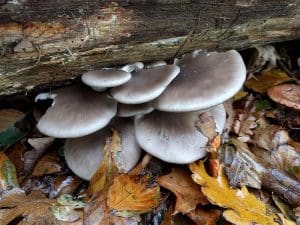
Stem
They have a short centre stem or nub
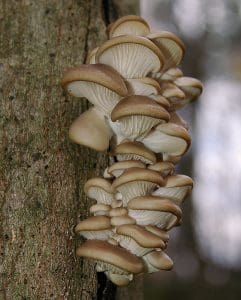
Gills
The white to ocre gills are decurrent running from the cap edge all the way down the nub.
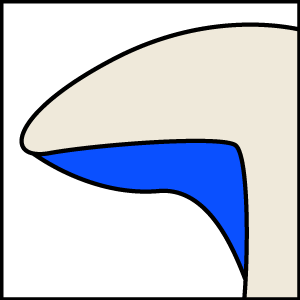
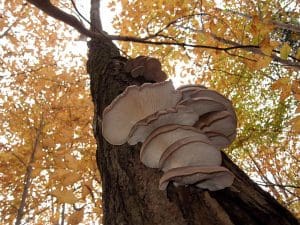
Spores
They have white kidney-shaped spores and often leave a spore print on the mushroom below.
Smell
They have a faint mushroomy smell.
Folklore, tall tales, and not so folklore:
Oyster Mushrooms are carnivorous, The mycelium will digest bacteria and small insects like nematodes that it comes across inside the wood it’s growing in.
Edible Use:
Oysters are a prized edible mushroom, they’re easily cultivated even from wild mushrooms, you can easily grow your own. For this reason, you often find oyster mushrooms in shops. It’s frequently used in Asian cookery, soups, stews, and stuffed. Personally, I find the younger mushrooms have a much better taste and texture than the older specimens.
Herbal:
Oyster mushroom is a rich source of protein, vitamins, minerals, fibre and other antioxidants. It’s also a source of selenium, which helps protect the cells from damage and help strengthen the immune system.



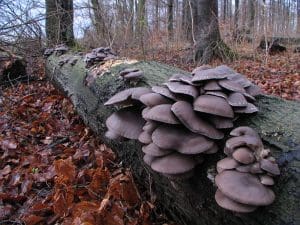
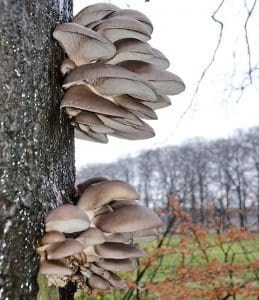



Leave a Reply
You must be logged in to post a comment.